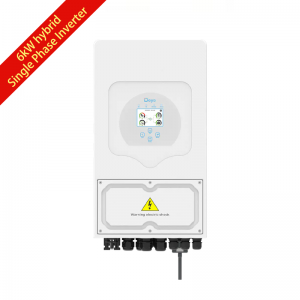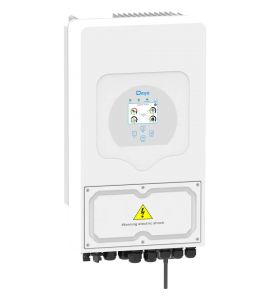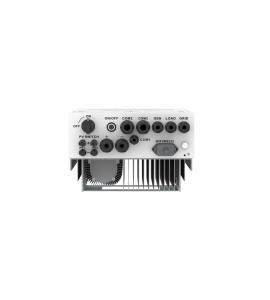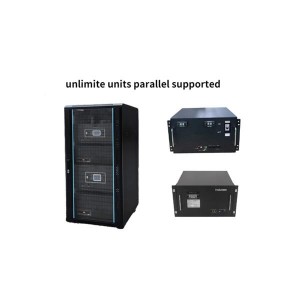

Deye 6kW Single Phase Hybrid Solar Inverter
ABOUT
Deye 6kW Single Phase Hybrid Solar Inverter
| Model | SUN-6K-SG03LP1-EU |
| Battery Input Data | |
| Battery Type | Lead-acid or Li-ion |
| Battery Voltage Range (V) | 40~60V |
| Max. Charging Current (A) | 135 |
| Max. Discharging Current (A) | 135 |
| Charging Curve | 3 Stages / Equalization |
| External Temperature Sensor | Yes |
| Charging Strategy for Li-Ion Battery | Self-adaption to BMS |
| PV String Input Data | |
| Max. DC Input Power (W) | 7800 |
| Rated PV Input Voltage (V) | 370(125~500) |
| Start-up Voltage (V) | 125 |
| MPPT Range (V) | 150-425 |
| Full Load DC Voltage Range (V) | 300-425 |
| PV Input Current (A) | 13+13 |
| Max. PV ISC (A) | 17+17 |
| Number of MPPT / Strings per MPPT | 2/1+1 |
| AC Output Data | |
| Rated AC Output and UPS Power (W) | 6000 |
| Max. AC Output Power (W) | 6600 |
| Peak Power (off grid) | 2 times of rated power, 10 S |
| Power Factor | 0.8 leading to 0.8 lagging |
| Max. Continuous AC Passthrough (A) | 40 |
| Output Frequency and Voltage | 50/60Hz;L/N/PE 220/230Vac(single phase) |
| Grid Type | Single Phase |
| Current Harmonic Distortion | THD<3% (Linear load<1.5%) |
| Efficiency | |
| Max. Efficiency | 97.60% |
| Euro Efficiency | 97.00% |
| MPPT Efficiency | 99.90% |
| Protection | |
| PV Input Lightning Protection | Integrated |
| Anti-islanding Protection | Integrated |
| PV String Input Reverse Polarity Protection | Integrated |
| Insulation Resistor Detection | Integrated |
| Residual Current Monitoring Unit | Integrated |
| Output Over Current Protection | Integrated |
| Output Shorted Protection | Integrated |
| Surge protection | Integrated |
| Certifications and Standards | |
| Grid Regulation | CEI 0-21, VDE-AR-N 4105, NRS 097, IEC 62116, IEC 61727, G99, G98, VDE 0126-1-1, RD 1699, C10-11 |
| Safety EMC / Standard | IEC/EN 61000-6-1/2/3/4, IEC/EN 62109-1, IEC/EN 62109-2 |
| General Data | |
| Operating Temperature Range (℃) | -45~60℃, >45℃ Derating |
| Cooling | Natural cooling |
| Noise (dB) | <30 dB |
| Communication with BMS | RS485; CAN |
| Weight (kg) | 20.5 |
| Size (mm) | 330W×580H×232D |
| Protection Degree | IP65 |
| Installation Style | Wall-mounted |
| Warranty | 5 years |
Application Scenarios of Energy Storage Inverters
The solar inverter has three major functions, including peak regulation, backup power supply and independent power supply. In terms of regions, peak shaving is the demand of Europe. In recent years, German electricity prices have continued to rise. In 2021, the electricity price for German residents has reached 34 cents/kWh, while the LCOE of photovoltaic/photovoltaic distribution and storage is only 9.3/14.1 cents/kWh, which is 73%/59% lower than the residential electricity price. The difference between the cost of photovoltaic power distribution and storage will continue to widen. Household photovoltaic distribution and storage systems can reduce electricity costs, so users in areas with high electricity prices have a strong incentive to install household storage.
In the peak shaving market, users mostly choose hybrid solar inverters and AC-coupled battery systems, which are more cost-effective and easier to manufacture. Off-grid battery inverter chargers with heavy-duty transformers are more expensive, hybrid soalr inverters and AC-coupled battery systems using light-duty inverters have lower inrush and peak power output ratings, but are more cost-effective and more Cheaper and easier to manufacture.
The backup power supply is needed by the United States and Japan, and the independent power supply is just in demand in the market, including South Africa and other regions. The application of household photovoltaic distribution storage system can reduce the dependence on the power grid and increase the reliability of power supply on the user side. Independent power supply is just a market demand. South Africa, Pakistan, Lebanon, the Philippines, Vietnam and other countries have tight global supply chains, and the national infrastructure is not enough to support the public's electricity consumption. Therefore, users must equip household photovoltaic energy storage systems.
Hybrid solar inverters have certain limitations as a backup power source. Some hybrid inverters have no or limited backup power capability, so only small or essential loads like lighting and essential power circuits can be backed up during a power outage with a 3-5 second delay. Whereas off-grid inverters provide very high inrush and peak power output and can handle highly inductive loads. If the user plans to power high surge equipment such as water pumps, compressors, washing machines and power tools, the solar inverter must be able to handle the high inductive surge loads.






